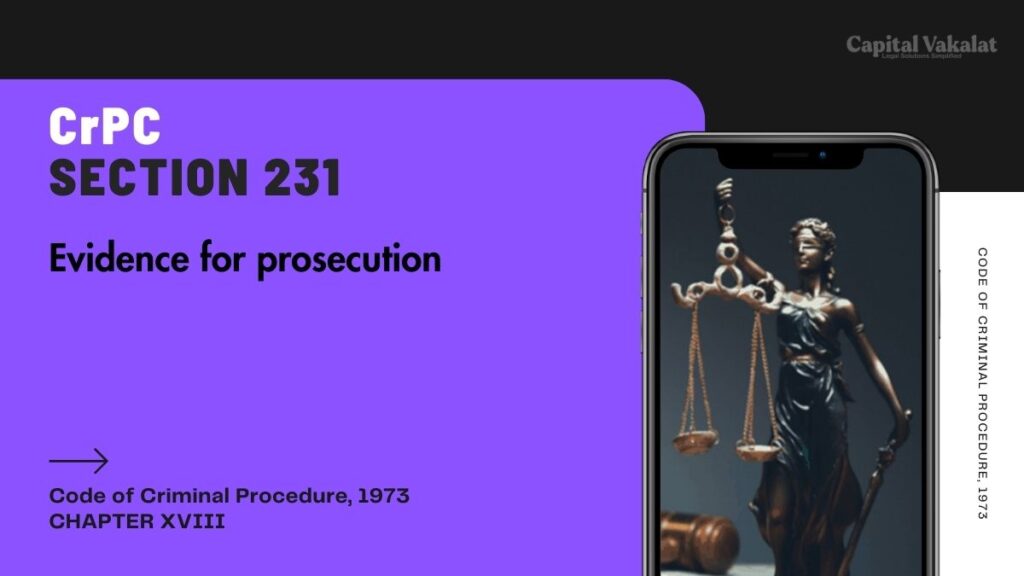The administration of criminal justice hinges on the effective collection and presentation of evidence. Section 231 of the Code of Criminal Procedure (CrPC) plays a pivotal role in this process, detailing the procedural norms for evidence in prosecution. Understanding its intricacies is crucial for legal professionals and stakeholders in the judicial system.

Section 231 of the CrPC outlines the methodology for presenting evidence during a criminal trial. It governs the prosecution’s duties, ensuring that evidence is presented in a manner that supports the prosecution’s case against the accused. This section is instrumental in maintaining the balance between the rights of the accused and the interests of justice.
Bare Act. Section 231 Cr.P.C.
Evidence for prosecution.
(1) On the date so fixed, the Judge shall proceed to take all such evidence as may be produced in support of the prosecution.
(2) The Judge may, in his discretion, permit the cross-examination of any witness to be deferred until any other witness or witnesses have been examined or recall any witness for further cross-examination.
Historical Context of Section 231
The roots of Section 231 can be traced back to the colonial era, where the British legal framework influenced Indian criminal law. Over time, the section has evolved, reflecting changes in legal principles and societal expectations. Its current form incorporates amendments aimed at strengthening the prosecution’s ability to present a robust case.
Importance of Evidence in Prosecution
Evidence forms the bedrock of any prosecution. It is the means through which the prosecution substantiates its allegations against the accused. Without credible evidence, the chances of securing a conviction diminish significantly, underscoring the importance of meticulous evidence gathering and presentation.
Types of Evidence Admissible
Documentary Evidence
Documentary evidence includes written documents that can substantiate claims made by the prosecution. This may range from official records to private communications.
Oral Evidence
Oral evidence involves witness testimonies. Witnesses recount their observations or experiences related to the case, providing firsthand accounts that support the prosecution’s narrative.
Material Evidence
Material evidence comprises physical objects that are presented during the trial. These can include weapons, clothing, or any tangible items relevant to the case.
Role of the Prosecution
The prosecution bears the onus of proving the guilt of the accused beyond a reasonable doubt. This involves a strategic presentation of evidence, adhering to the procedural guidelines outlined in Section 231. The prosecution must ensure that the evidence is credible, relevant, and sufficient to establish the accused’s guilt.
Steps Involved Under Section 231
The procedural steps under Section 231 include the examination of witnesses, presentation of documentary and material evidence, and the cross-examination by the defense. Each step is critical in building a coherent and compelling case.
Preparation of Evidence
Effective preparation involves gathering all pertinent evidence, verifying its authenticity, and organizing it in a logical sequence. This preparatory phase is crucial for the seamless presentation of evidence during the trial.
Admissibility Criteria
Relevance
Evidence must be directly related to the case. Irrelevant evidence can lead to objections and its eventual exclusion from the trial.
Authenticity
The authenticity of evidence ensures that it is genuine and unaltered. This is vital for maintaining the integrity of the judicial process.
Burden of Proof
The burden of proof lies with the prosecution. This means that the prosecution must establish the accused’s guilt through incontrovertible evidence, convincing the court beyond a reasonable doubt.
Cross-Examination
Cross-examination is a crucial component of the trial process under Section 231. It allows the defense to challenge the evidence presented by the prosecution, testing its veracity and reliability.
Judicial Discretion in Evidence Assessment
Judges possess significant discretion in assessing the admissibility and relevance of evidence. Their decisions can significantly impact the outcome of the trial, highlighting the importance of judicial acumen and fairness.
Challenges Faced by Prosecution
The prosecution often encounters challenges such as witness tampering, evidence contamination, and procedural delays. Overcoming these hurdles requires diligence, strategic planning, and adherence to legal protocols.
Case Studies and Precedents
Studying landmark cases and judicial precedents provides valuable insights into the application of Section 231. These cases illustrate the practical challenges and judicial interpretations that shape the implementation of this section.
Recent Amendments and Their Impact
Recent amendments to Section 231 reflect an evolving legal landscape. These changes aim to enhance the efficiency of the trial process and the robustness of evidence presentation, adapting to contemporary legal needs.
Comparative Analysis with Other Jurisdictions
Comparing Section 231 with similar provisions in other jurisdictions reveals different approaches to evidence in prosecution. Such analysis can offer lessons and best practices that could be adapted to improve the Indian criminal justice system.
Best Practices for Evidence Collection
Adopting best practices in evidence collection ensures its integrity and admissibility. This includes meticulous documentation, chain of custody maintenance, and proper storage of physical evidence.
Technological Advancements in Evidence Gathering
Technological advancements have revolutionized evidence gathering. Tools such as digital forensics, surveillance technologies, and data analytics enhance the accuracy and comprehensiveness of evidence.
Impact of Section 231 on Legal Outcomes
Section 231 significantly influences legal outcomes by dictating how evidence is presented and scrutinized during trials. Its effective application can lead to fair and just verdicts, reinforcing public trust in the judicial system.
Conclusion
Section 231 of the CrPC is a cornerstone of the criminal justice system, ensuring that the prosecution presents evidence effectively and fairly. Understanding its provisions, challenges, and best practices is essential for legal professionals and stakeholders committed to upholding justice. As legal landscapes evolve, continuous learning and adaptation will ensure that Section 231 remains robust and effective in delivering fair outcomes.